Enterprise Environmental Factors Analysis at Quasar Communications
VerifiedAdded on 2023/06/08
|12
|2409
|106
Report
AI Summary
This report provides an in-depth analysis of the Enterprise Environmental Factors (EEF) affecting Quasar Communications Inc., a communications company. It evaluates both internal and external factors, such as industry conditions, political and economic climates, risk tolerances, and regulatory standards, and their impact on project management processes. The report also develops strategies for implementing proper activities, including defining scopes, evaluating options, documenting procedures, and considering customization. Furthermore, it outlines drafted communication plans targeting different stakeholders, emphasizing the importance of regular meetings and transparent communication to address concerns and ensure project success. The study concludes that understanding and managing EEFs, both internal and external, are crucial for the successful execution of projects within Quasar Communications.
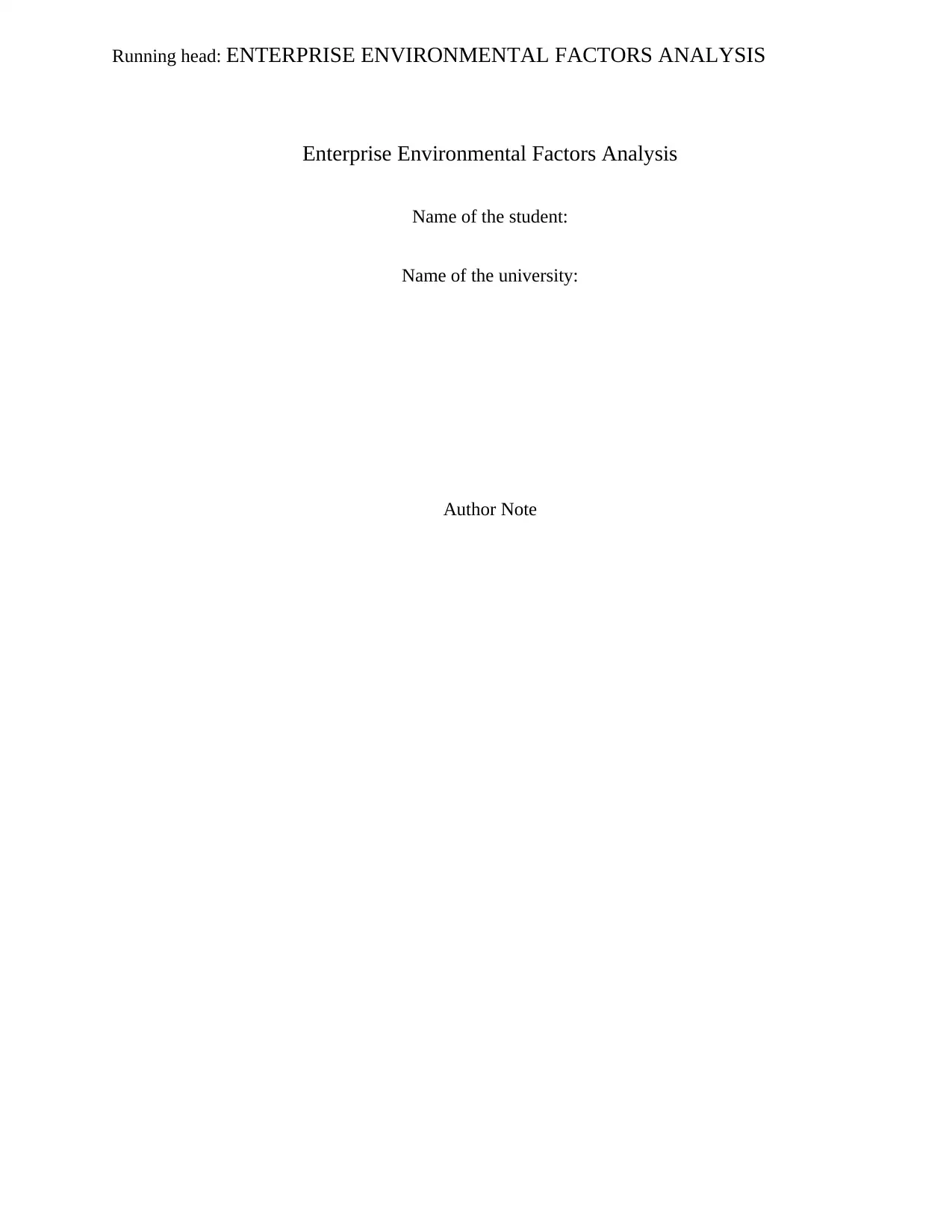
Running head: ENTERPRISE ENVIRONMENTAL FACTORS ANALYSIS
Enterprise Environmental Factors Analysis
Name of the student:
Name of the university:
Author Note
Enterprise Environmental Factors Analysis
Name of the student:
Name of the university:
Author Note
Paraphrase This Document
Need a fresh take? Get an instant paraphrase of this document with our AI Paraphraser
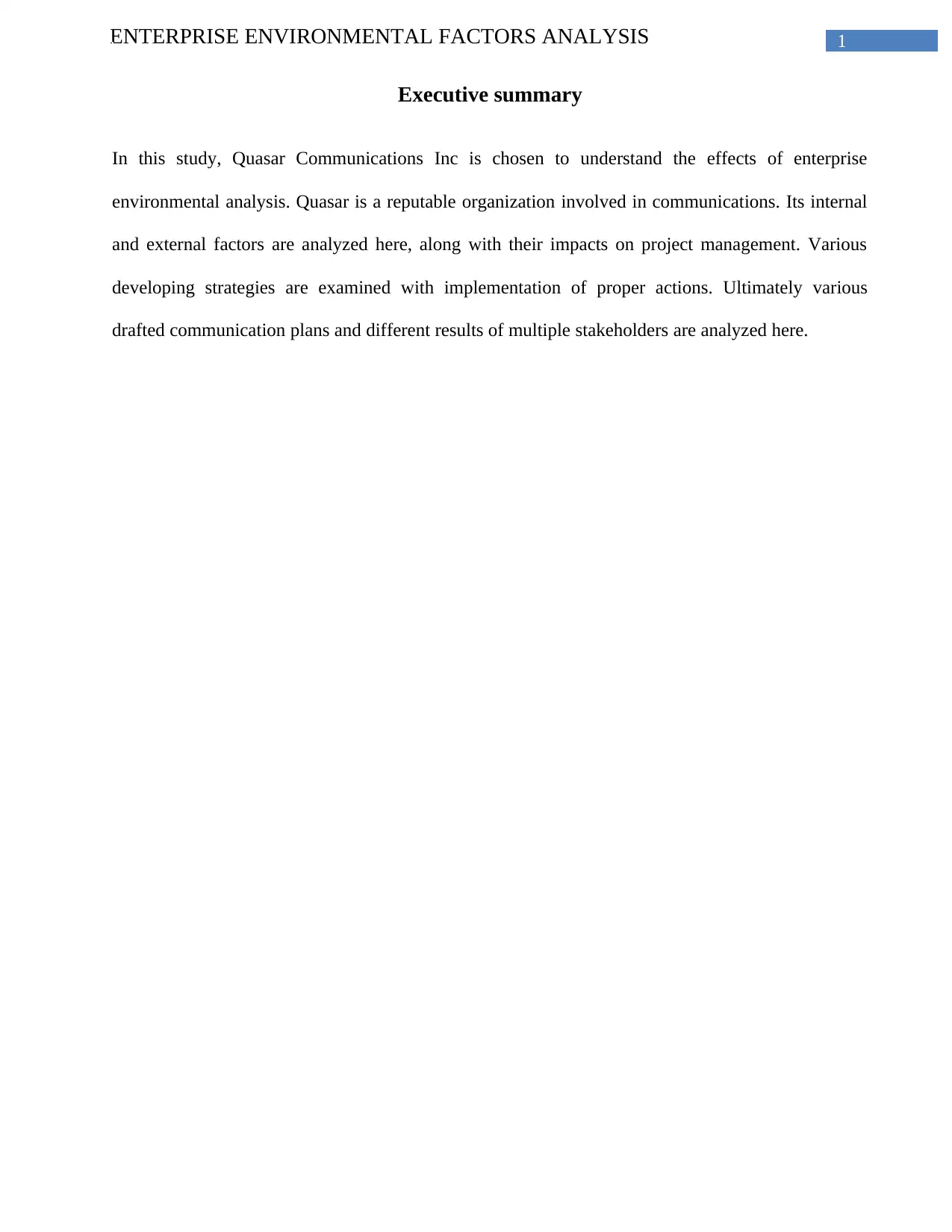
1ENTERPRISE ENVIRONMENTAL FACTORS ANALYSIS
Executive summary
In this study, Quasar Communications Inc is chosen to understand the effects of enterprise
environmental analysis. Quasar is a reputable organization involved in communications. Its internal
and external factors are analyzed here, along with their impacts on project management. Various
developing strategies are examined with implementation of proper actions. Ultimately various
drafted communication plans and different results of multiple stakeholders are analyzed here.
Executive summary
In this study, Quasar Communications Inc is chosen to understand the effects of enterprise
environmental analysis. Quasar is a reputable organization involved in communications. Its internal
and external factors are analyzed here, along with their impacts on project management. Various
developing strategies are examined with implementation of proper actions. Ultimately various
drafted communication plans and different results of multiple stakeholders are analyzed here.
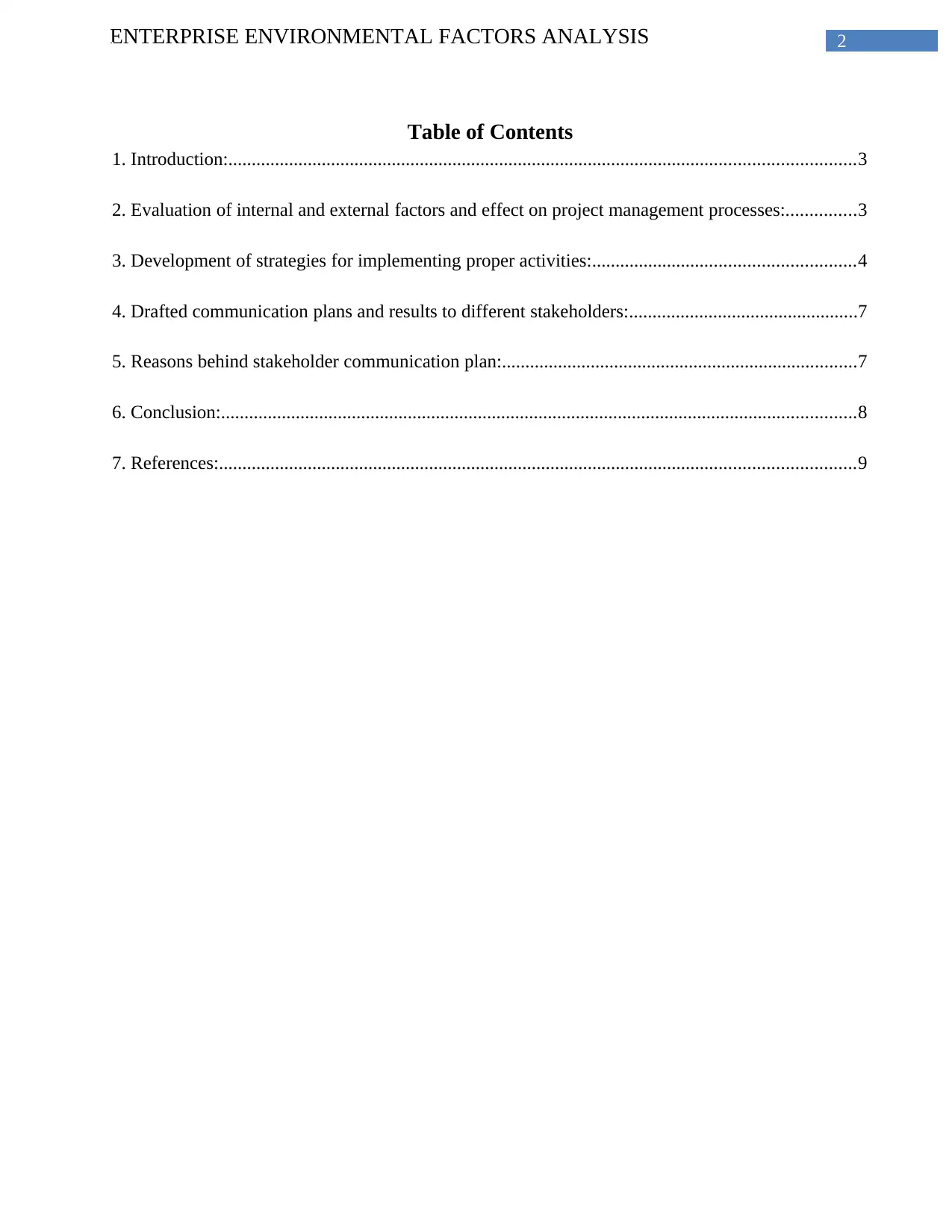
2ENTERPRISE ENVIRONMENTAL FACTORS ANALYSIS
Table of Contents
1. Introduction:......................................................................................................................................3
2. Evaluation of internal and external factors and effect on project management processes:...............3
3. Development of strategies for implementing proper activities:........................................................4
4. Drafted communication plans and results to different stakeholders:.................................................7
5. Reasons behind stakeholder communication plan:............................................................................7
6. Conclusion:........................................................................................................................................8
7. References:........................................................................................................................................9
Table of Contents
1. Introduction:......................................................................................................................................3
2. Evaluation of internal and external factors and effect on project management processes:...............3
3. Development of strategies for implementing proper activities:........................................................4
4. Drafted communication plans and results to different stakeholders:.................................................7
5. Reasons behind stakeholder communication plan:............................................................................7
6. Conclusion:........................................................................................................................................8
7. References:........................................................................................................................................9
⊘ This is a preview!⊘
Do you want full access?
Subscribe today to unlock all pages.

Trusted by 1+ million students worldwide
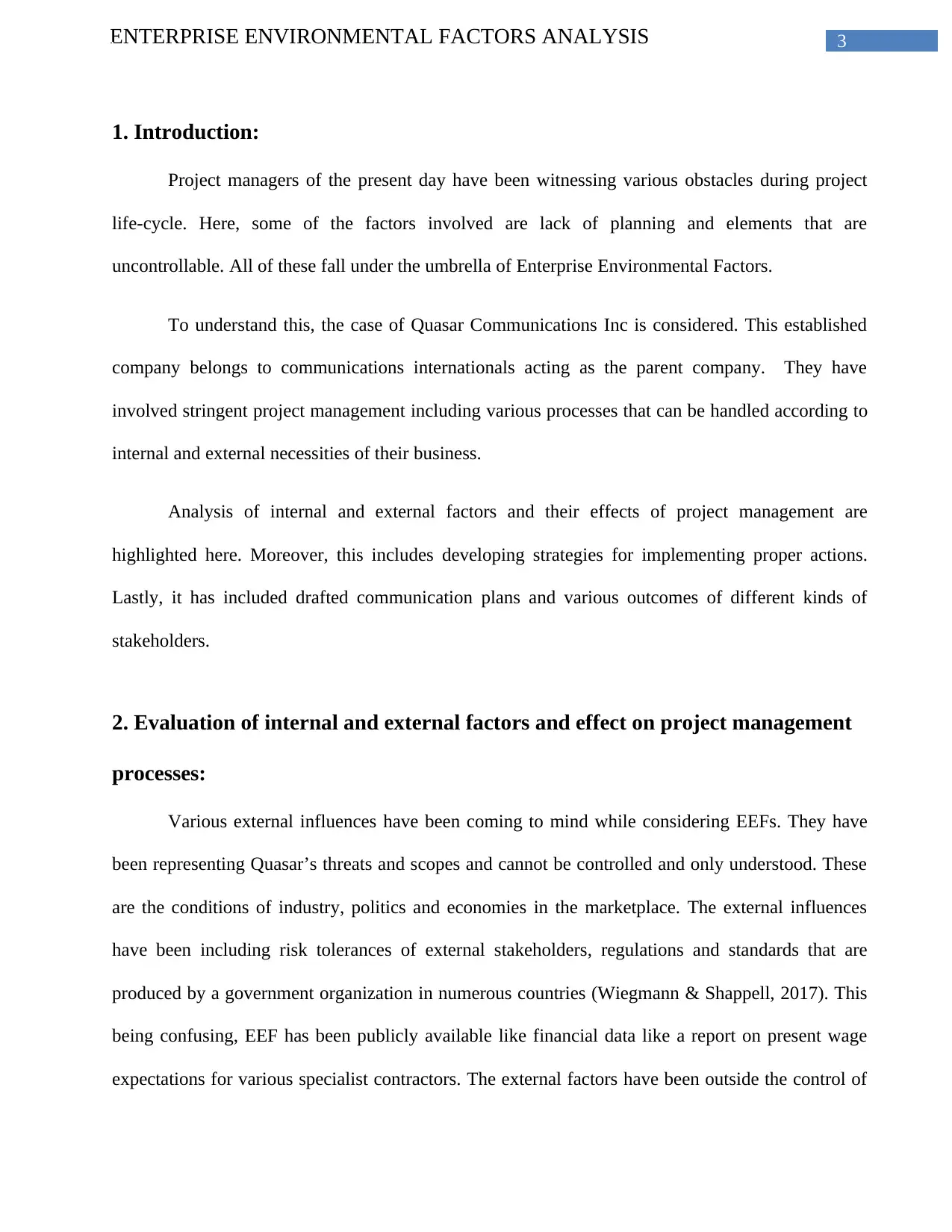
3ENTERPRISE ENVIRONMENTAL FACTORS ANALYSIS
1. Introduction:
Project managers of the present day have been witnessing various obstacles during project
life-cycle. Here, some of the factors involved are lack of planning and elements that are
uncontrollable. All of these fall under the umbrella of Enterprise Environmental Factors.
To understand this, the case of Quasar Communications Inc is considered. This established
company belongs to communications internationals acting as the parent company. They have
involved stringent project management including various processes that can be handled according to
internal and external necessities of their business.
Analysis of internal and external factors and their effects of project management are
highlighted here. Moreover, this includes developing strategies for implementing proper actions.
Lastly, it has included drafted communication plans and various outcomes of different kinds of
stakeholders.
2. Evaluation of internal and external factors and effect on project management
processes:
Various external influences have been coming to mind while considering EEFs. They have
been representing Quasar’s threats and scopes and cannot be controlled and only understood. These
are the conditions of industry, politics and economies in the marketplace. The external influences
have been including risk tolerances of external stakeholders, regulations and standards that are
produced by a government organization in numerous countries (Wiegmann & Shappell, 2017). This
being confusing, EEF has been publicly available like financial data like a report on present wage
expectations for various specialist contractors. The external factors have been outside the control of
1. Introduction:
Project managers of the present day have been witnessing various obstacles during project
life-cycle. Here, some of the factors involved are lack of planning and elements that are
uncontrollable. All of these fall under the umbrella of Enterprise Environmental Factors.
To understand this, the case of Quasar Communications Inc is considered. This established
company belongs to communications internationals acting as the parent company. They have
involved stringent project management including various processes that can be handled according to
internal and external necessities of their business.
Analysis of internal and external factors and their effects of project management are
highlighted here. Moreover, this includes developing strategies for implementing proper actions.
Lastly, it has included drafted communication plans and various outcomes of different kinds of
stakeholders.
2. Evaluation of internal and external factors and effect on project management
processes:
Various external influences have been coming to mind while considering EEFs. They have
been representing Quasar’s threats and scopes and cannot be controlled and only understood. These
are the conditions of industry, politics and economies in the marketplace. The external influences
have been including risk tolerances of external stakeholders, regulations and standards that are
produced by a government organization in numerous countries (Wiegmann & Shappell, 2017). This
being confusing, EEF has been publicly available like financial data like a report on present wage
expectations for various specialist contractors. The external factors have been outside the control of
Paraphrase This Document
Need a fresh take? Get an instant paraphrase of this document with our AI Paraphraser
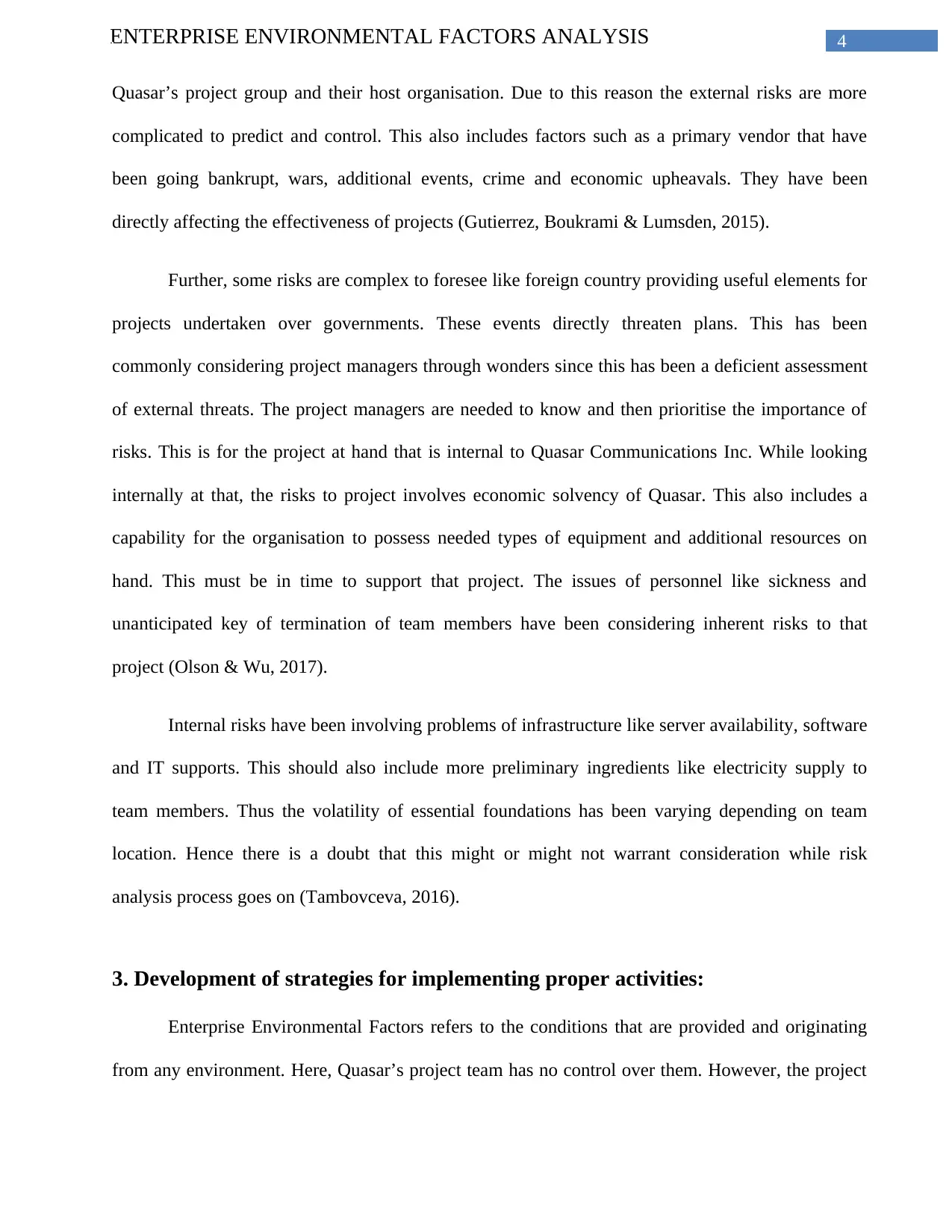
4ENTERPRISE ENVIRONMENTAL FACTORS ANALYSIS
Quasar’s project group and their host organisation. Due to this reason the external risks are more
complicated to predict and control. This also includes factors such as a primary vendor that have
been going bankrupt, wars, additional events, crime and economic upheavals. They have been
directly affecting the effectiveness of projects (Gutierrez, Boukrami & Lumsden, 2015).
Further, some risks are complex to foresee like foreign country providing useful elements for
projects undertaken over governments. These events directly threaten plans. This has been
commonly considering project managers through wonders since this has been a deficient assessment
of external threats. The project managers are needed to know and then prioritise the importance of
risks. This is for the project at hand that is internal to Quasar Communications Inc. While looking
internally at that, the risks to project involves economic solvency of Quasar. This also includes a
capability for the organisation to possess needed types of equipment and additional resources on
hand. This must be in time to support that project. The issues of personnel like sickness and
unanticipated key of termination of team members have been considering inherent risks to that
project (Olson & Wu, 2017).
Internal risks have been involving problems of infrastructure like server availability, software
and IT supports. This should also include more preliminary ingredients like electricity supply to
team members. Thus the volatility of essential foundations has been varying depending on team
location. Hence there is a doubt that this might or might not warrant consideration while risk
analysis process goes on (Tambovceva, 2016).
3. Development of strategies for implementing proper activities:
Enterprise Environmental Factors refers to the conditions that are provided and originating
from any environment. Here, Quasar’s project team has no control over them. However, the project
Quasar’s project group and their host organisation. Due to this reason the external risks are more
complicated to predict and control. This also includes factors such as a primary vendor that have
been going bankrupt, wars, additional events, crime and economic upheavals. They have been
directly affecting the effectiveness of projects (Gutierrez, Boukrami & Lumsden, 2015).
Further, some risks are complex to foresee like foreign country providing useful elements for
projects undertaken over governments. These events directly threaten plans. This has been
commonly considering project managers through wonders since this has been a deficient assessment
of external threats. The project managers are needed to know and then prioritise the importance of
risks. This is for the project at hand that is internal to Quasar Communications Inc. While looking
internally at that, the risks to project involves economic solvency of Quasar. This also includes a
capability for the organisation to possess needed types of equipment and additional resources on
hand. This must be in time to support that project. The issues of personnel like sickness and
unanticipated key of termination of team members have been considering inherent risks to that
project (Olson & Wu, 2017).
Internal risks have been involving problems of infrastructure like server availability, software
and IT supports. This should also include more preliminary ingredients like electricity supply to
team members. Thus the volatility of essential foundations has been varying depending on team
location. Hence there is a doubt that this might or might not warrant consideration while risk
analysis process goes on (Tambovceva, 2016).
3. Development of strategies for implementing proper activities:
Enterprise Environmental Factors refers to the conditions that are provided and originating
from any environment. Here, Quasar’s project team has no control over them. However, the project
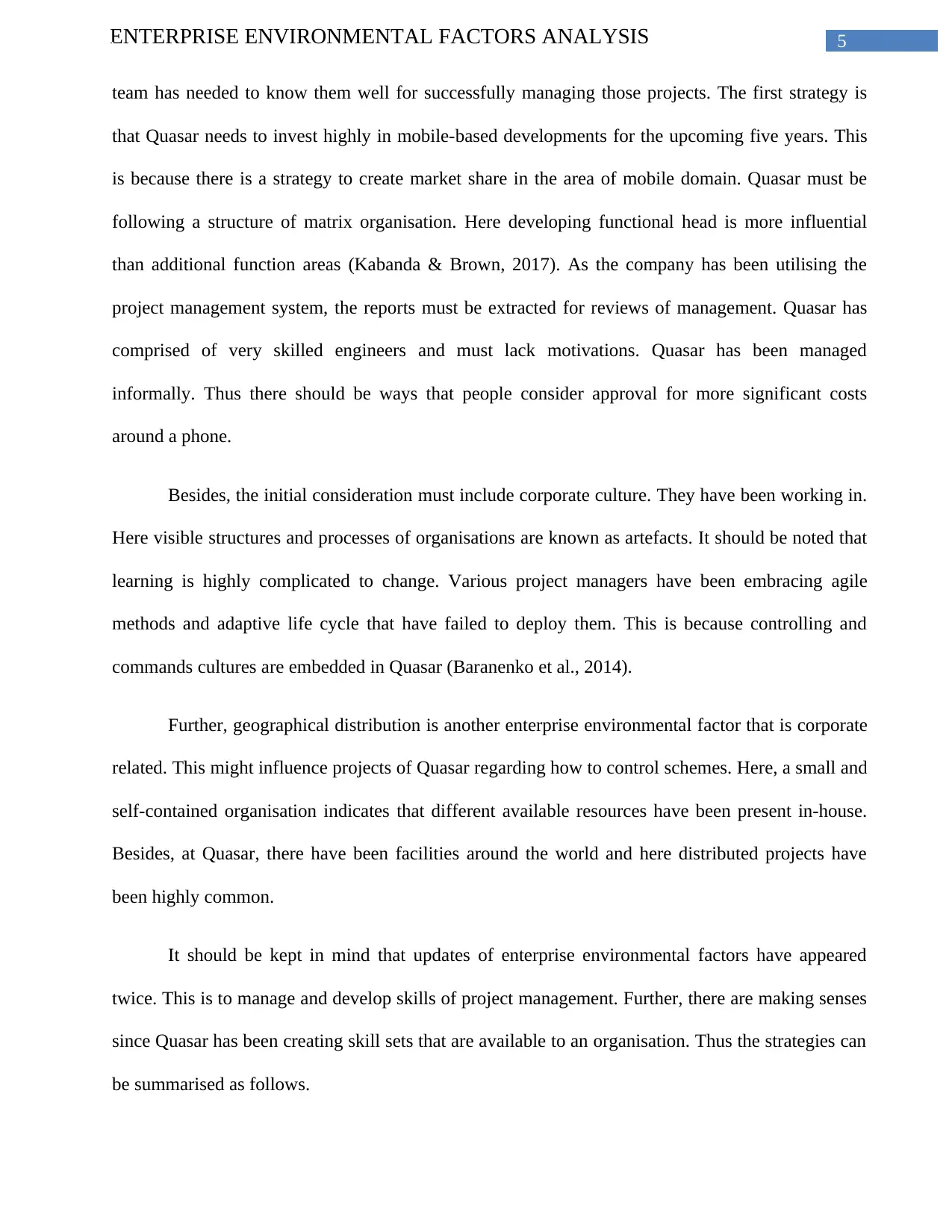
5ENTERPRISE ENVIRONMENTAL FACTORS ANALYSIS
team has needed to know them well for successfully managing those projects. The first strategy is
that Quasar needs to invest highly in mobile-based developments for the upcoming five years. This
is because there is a strategy to create market share in the area of mobile domain. Quasar must be
following a structure of matrix organisation. Here developing functional head is more influential
than additional function areas (Kabanda & Brown, 2017). As the company has been utilising the
project management system, the reports must be extracted for reviews of management. Quasar has
comprised of very skilled engineers and must lack motivations. Quasar has been managed
informally. Thus there should be ways that people consider approval for more significant costs
around a phone.
Besides, the initial consideration must include corporate culture. They have been working in.
Here visible structures and processes of organisations are known as artefacts. It should be noted that
learning is highly complicated to change. Various project managers have been embracing agile
methods and adaptive life cycle that have failed to deploy them. This is because controlling and
commands cultures are embedded in Quasar (Baranenko et al., 2014).
Further, geographical distribution is another enterprise environmental factor that is corporate
related. This might influence projects of Quasar regarding how to control schemes. Here, a small and
self-contained organisation indicates that different available resources have been present in-house.
Besides, at Quasar, there have been facilities around the world and here distributed projects have
been highly common.
It should be kept in mind that updates of enterprise environmental factors have appeared
twice. This is to manage and develop skills of project management. Further, there are making senses
since Quasar has been creating skill sets that are available to an organisation. Thus the strategies can
be summarised as follows.
team has needed to know them well for successfully managing those projects. The first strategy is
that Quasar needs to invest highly in mobile-based developments for the upcoming five years. This
is because there is a strategy to create market share in the area of mobile domain. Quasar must be
following a structure of matrix organisation. Here developing functional head is more influential
than additional function areas (Kabanda & Brown, 2017). As the company has been utilising the
project management system, the reports must be extracted for reviews of management. Quasar has
comprised of very skilled engineers and must lack motivations. Quasar has been managed
informally. Thus there should be ways that people consider approval for more significant costs
around a phone.
Besides, the initial consideration must include corporate culture. They have been working in.
Here visible structures and processes of organisations are known as artefacts. It should be noted that
learning is highly complicated to change. Various project managers have been embracing agile
methods and adaptive life cycle that have failed to deploy them. This is because controlling and
commands cultures are embedded in Quasar (Baranenko et al., 2014).
Further, geographical distribution is another enterprise environmental factor that is corporate
related. This might influence projects of Quasar regarding how to control schemes. Here, a small and
self-contained organisation indicates that different available resources have been present in-house.
Besides, at Quasar, there have been facilities around the world and here distributed projects have
been highly common.
It should be kept in mind that updates of enterprise environmental factors have appeared
twice. This is to manage and develop skills of project management. Further, there are making senses
since Quasar has been creating skill sets that are available to an organisation. Thus the strategies can
be summarised as follows.
⊘ This is a preview!⊘
Do you want full access?
Subscribe today to unlock all pages.

Trusted by 1+ million students worldwide
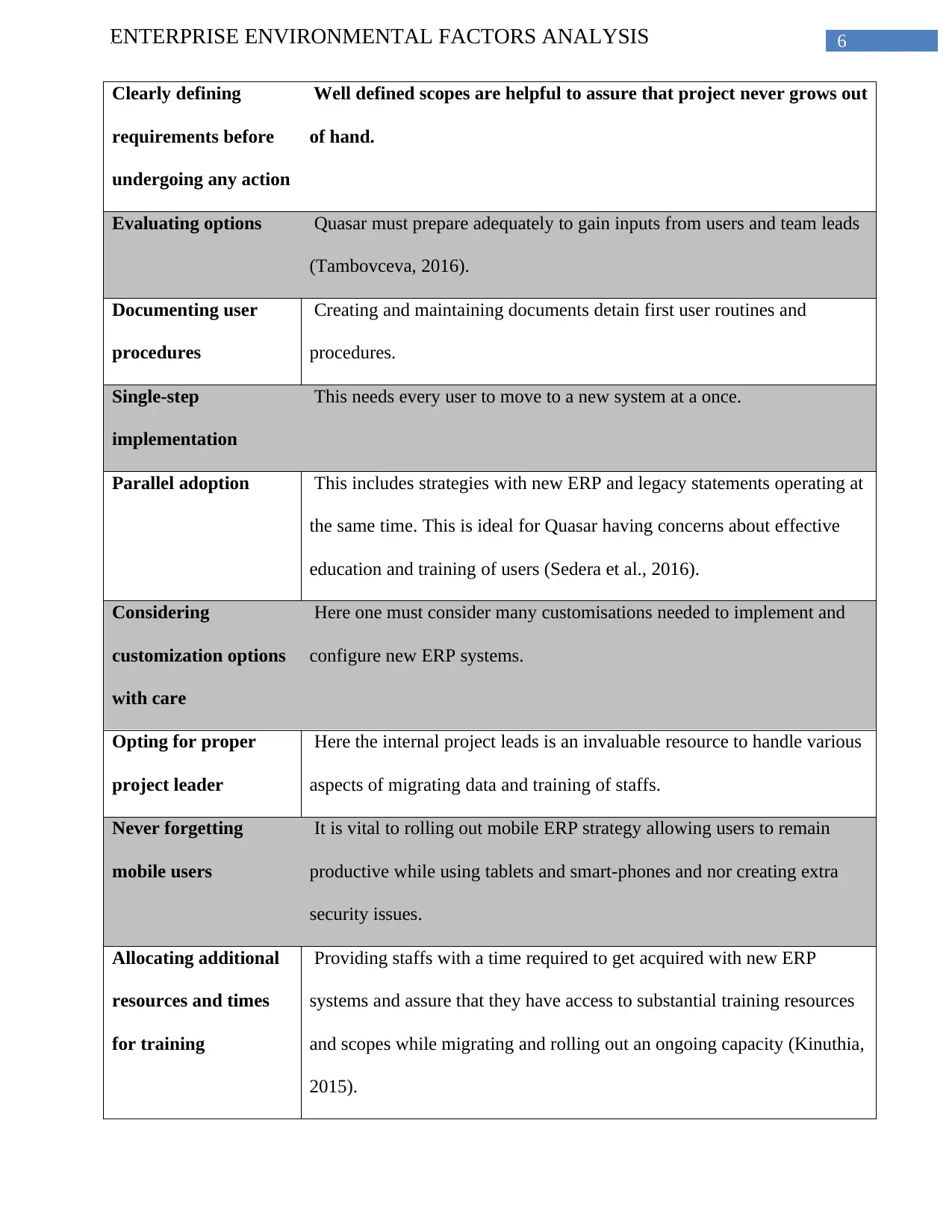
6ENTERPRISE ENVIRONMENTAL FACTORS ANALYSIS
Clearly defining
requirements before
undergoing any action
Well defined scopes are helpful to assure that project never grows out
of hand.
Evaluating options Quasar must prepare adequately to gain inputs from users and team leads
(Tambovceva, 2016).
Documenting user
procedures
Creating and maintaining documents detain first user routines and
procedures.
Single-step
implementation
This needs every user to move to a new system at a once.
Parallel adoption This includes strategies with new ERP and legacy statements operating at
the same time. This is ideal for Quasar having concerns about effective
education and training of users (Sedera et al., 2016).
Considering
customization options
with care
Here one must consider many customisations needed to implement and
configure new ERP systems.
Opting for proper
project leader
Here the internal project leads is an invaluable resource to handle various
aspects of migrating data and training of staffs.
Never forgetting
mobile users
It is vital to rolling out mobile ERP strategy allowing users to remain
productive while using tablets and smart-phones and nor creating extra
security issues.
Allocating additional
resources and times
for training
Providing staffs with a time required to get acquired with new ERP
systems and assure that they have access to substantial training resources
and scopes while migrating and rolling out an ongoing capacity (Kinuthia,
2015).
Clearly defining
requirements before
undergoing any action
Well defined scopes are helpful to assure that project never grows out
of hand.
Evaluating options Quasar must prepare adequately to gain inputs from users and team leads
(Tambovceva, 2016).
Documenting user
procedures
Creating and maintaining documents detain first user routines and
procedures.
Single-step
implementation
This needs every user to move to a new system at a once.
Parallel adoption This includes strategies with new ERP and legacy statements operating at
the same time. This is ideal for Quasar having concerns about effective
education and training of users (Sedera et al., 2016).
Considering
customization options
with care
Here one must consider many customisations needed to implement and
configure new ERP systems.
Opting for proper
project leader
Here the internal project leads is an invaluable resource to handle various
aspects of migrating data and training of staffs.
Never forgetting
mobile users
It is vital to rolling out mobile ERP strategy allowing users to remain
productive while using tablets and smart-phones and nor creating extra
security issues.
Allocating additional
resources and times
for training
Providing staffs with a time required to get acquired with new ERP
systems and assure that they have access to substantial training resources
and scopes while migrating and rolling out an ongoing capacity (Kinuthia,
2015).
Paraphrase This Document
Need a fresh take? Get an instant paraphrase of this document with our AI Paraphraser
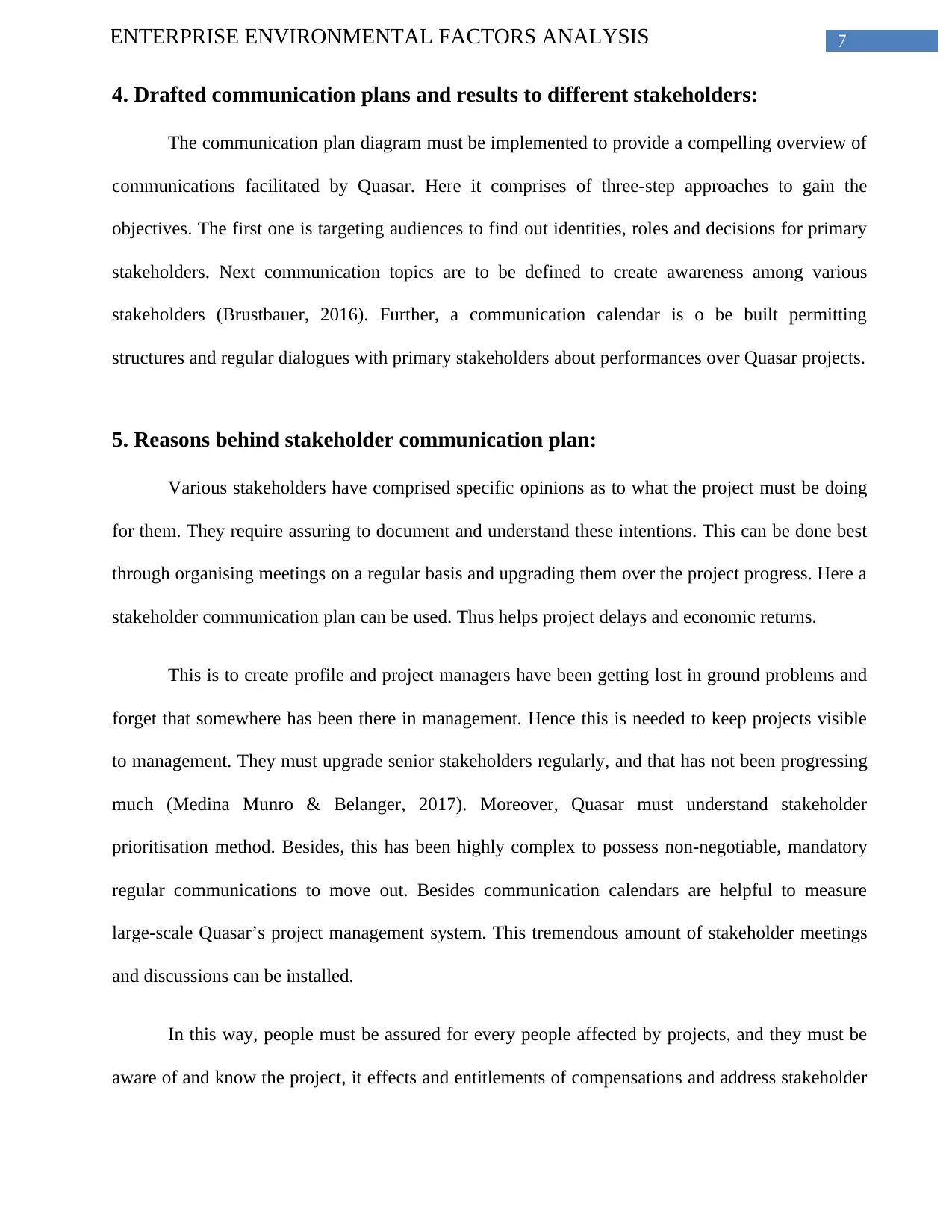
7ENTERPRISE ENVIRONMENTAL FACTORS ANALYSIS
4. Drafted communication plans and results to different stakeholders:
The communication plan diagram must be implemented to provide a compelling overview of
communications facilitated by Quasar. Here it comprises of three-step approaches to gain the
objectives. The first one is targeting audiences to find out identities, roles and decisions for primary
stakeholders. Next communication topics are to be defined to create awareness among various
stakeholders (Brustbauer, 2016). Further, a communication calendar is o be built permitting
structures and regular dialogues with primary stakeholders about performances over Quasar projects.
5. Reasons behind stakeholder communication plan:
Various stakeholders have comprised specific opinions as to what the project must be doing
for them. They require assuring to document and understand these intentions. This can be done best
through organising meetings on a regular basis and upgrading them over the project progress. Here a
stakeholder communication plan can be used. Thus helps project delays and economic returns.
This is to create profile and project managers have been getting lost in ground problems and
forget that somewhere has been there in management. Hence this is needed to keep projects visible
to management. They must upgrade senior stakeholders regularly, and that has not been progressing
much (Medina Munro & Belanger, 2017). Moreover, Quasar must understand stakeholder
prioritisation method. Besides, this has been highly complex to possess non-negotiable, mandatory
regular communications to move out. Besides communication calendars are helpful to measure
large-scale Quasar’s project management system. This tremendous amount of stakeholder meetings
and discussions can be installed.
In this way, people must be assured for every people affected by projects, and they must be
aware of and know the project, it effects and entitlements of compensations and address stakeholder
4. Drafted communication plans and results to different stakeholders:
The communication plan diagram must be implemented to provide a compelling overview of
communications facilitated by Quasar. Here it comprises of three-step approaches to gain the
objectives. The first one is targeting audiences to find out identities, roles and decisions for primary
stakeholders. Next communication topics are to be defined to create awareness among various
stakeholders (Brustbauer, 2016). Further, a communication calendar is o be built permitting
structures and regular dialogues with primary stakeholders about performances over Quasar projects.
5. Reasons behind stakeholder communication plan:
Various stakeholders have comprised specific opinions as to what the project must be doing
for them. They require assuring to document and understand these intentions. This can be done best
through organising meetings on a regular basis and upgrading them over the project progress. Here a
stakeholder communication plan can be used. Thus helps project delays and economic returns.
This is to create profile and project managers have been getting lost in ground problems and
forget that somewhere has been there in management. Hence this is needed to keep projects visible
to management. They must upgrade senior stakeholders regularly, and that has not been progressing
much (Medina Munro & Belanger, 2017). Moreover, Quasar must understand stakeholder
prioritisation method. Besides, this has been highly complex to possess non-negotiable, mandatory
regular communications to move out. Besides communication calendars are helpful to measure
large-scale Quasar’s project management system. This tremendous amount of stakeholder meetings
and discussions can be installed.
In this way, people must be assured for every people affected by projects, and they must be
aware of and know the project, it effects and entitlements of compensations and address stakeholder
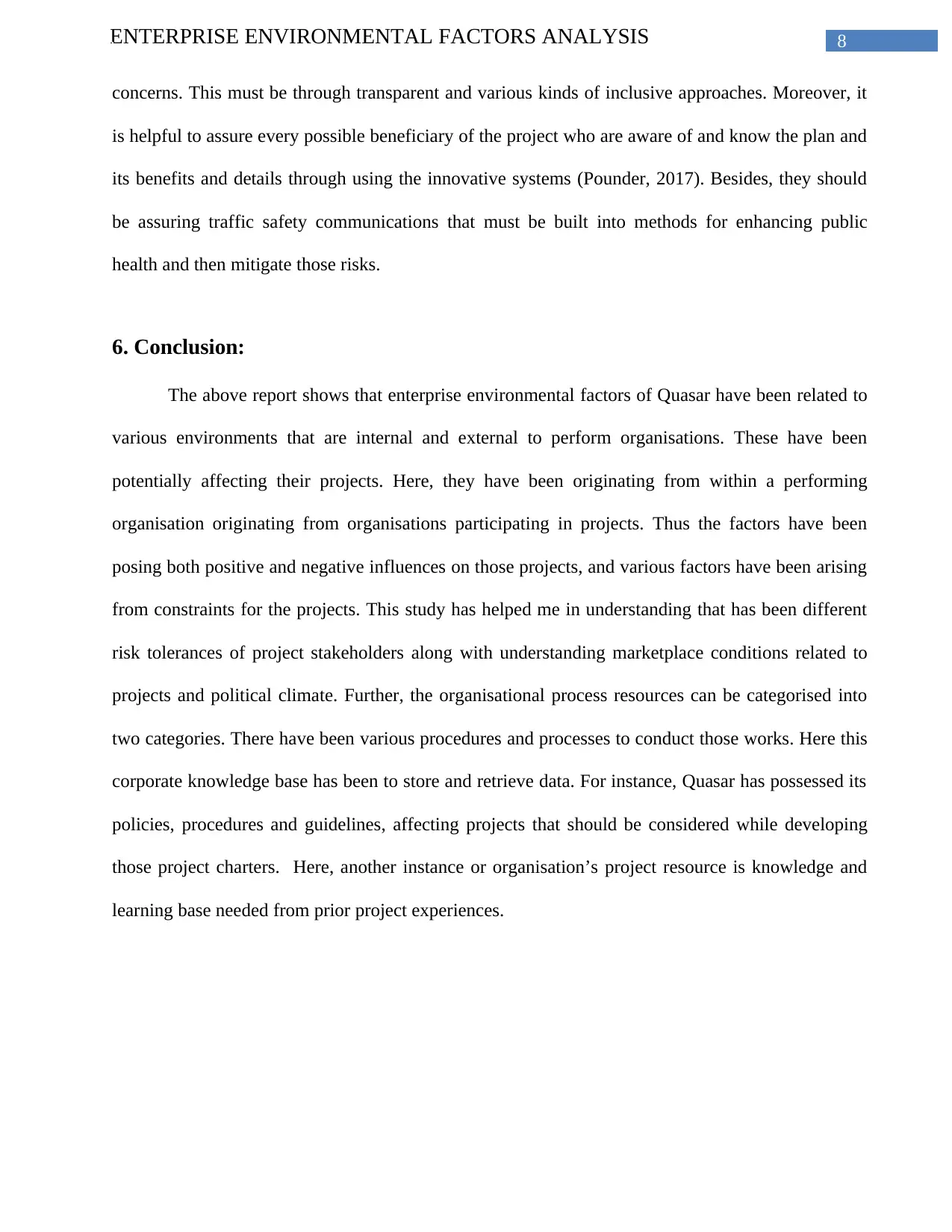
8ENTERPRISE ENVIRONMENTAL FACTORS ANALYSIS
concerns. This must be through transparent and various kinds of inclusive approaches. Moreover, it
is helpful to assure every possible beneficiary of the project who are aware of and know the plan and
its benefits and details through using the innovative systems (Pounder, 2017). Besides, they should
be assuring traffic safety communications that must be built into methods for enhancing public
health and then mitigate those risks.
6. Conclusion:
The above report shows that enterprise environmental factors of Quasar have been related to
various environments that are internal and external to perform organisations. These have been
potentially affecting their projects. Here, they have been originating from within a performing
organisation originating from organisations participating in projects. Thus the factors have been
posing both positive and negative influences on those projects, and various factors have been arising
from constraints for the projects. This study has helped me in understanding that has been different
risk tolerances of project stakeholders along with understanding marketplace conditions related to
projects and political climate. Further, the organisational process resources can be categorised into
two categories. There have been various procedures and processes to conduct those works. Here this
corporate knowledge base has been to store and retrieve data. For instance, Quasar has possessed its
policies, procedures and guidelines, affecting projects that should be considered while developing
those project charters. Here, another instance or organisation’s project resource is knowledge and
learning base needed from prior project experiences.
concerns. This must be through transparent and various kinds of inclusive approaches. Moreover, it
is helpful to assure every possible beneficiary of the project who are aware of and know the plan and
its benefits and details through using the innovative systems (Pounder, 2017). Besides, they should
be assuring traffic safety communications that must be built into methods for enhancing public
health and then mitigate those risks.
6. Conclusion:
The above report shows that enterprise environmental factors of Quasar have been related to
various environments that are internal and external to perform organisations. These have been
potentially affecting their projects. Here, they have been originating from within a performing
organisation originating from organisations participating in projects. Thus the factors have been
posing both positive and negative influences on those projects, and various factors have been arising
from constraints for the projects. This study has helped me in understanding that has been different
risk tolerances of project stakeholders along with understanding marketplace conditions related to
projects and political climate. Further, the organisational process resources can be categorised into
two categories. There have been various procedures and processes to conduct those works. Here this
corporate knowledge base has been to store and retrieve data. For instance, Quasar has possessed its
policies, procedures and guidelines, affecting projects that should be considered while developing
those project charters. Here, another instance or organisation’s project resource is knowledge and
learning base needed from prior project experiences.
⊘ This is a preview!⊘
Do you want full access?
Subscribe today to unlock all pages.

Trusted by 1+ million students worldwide
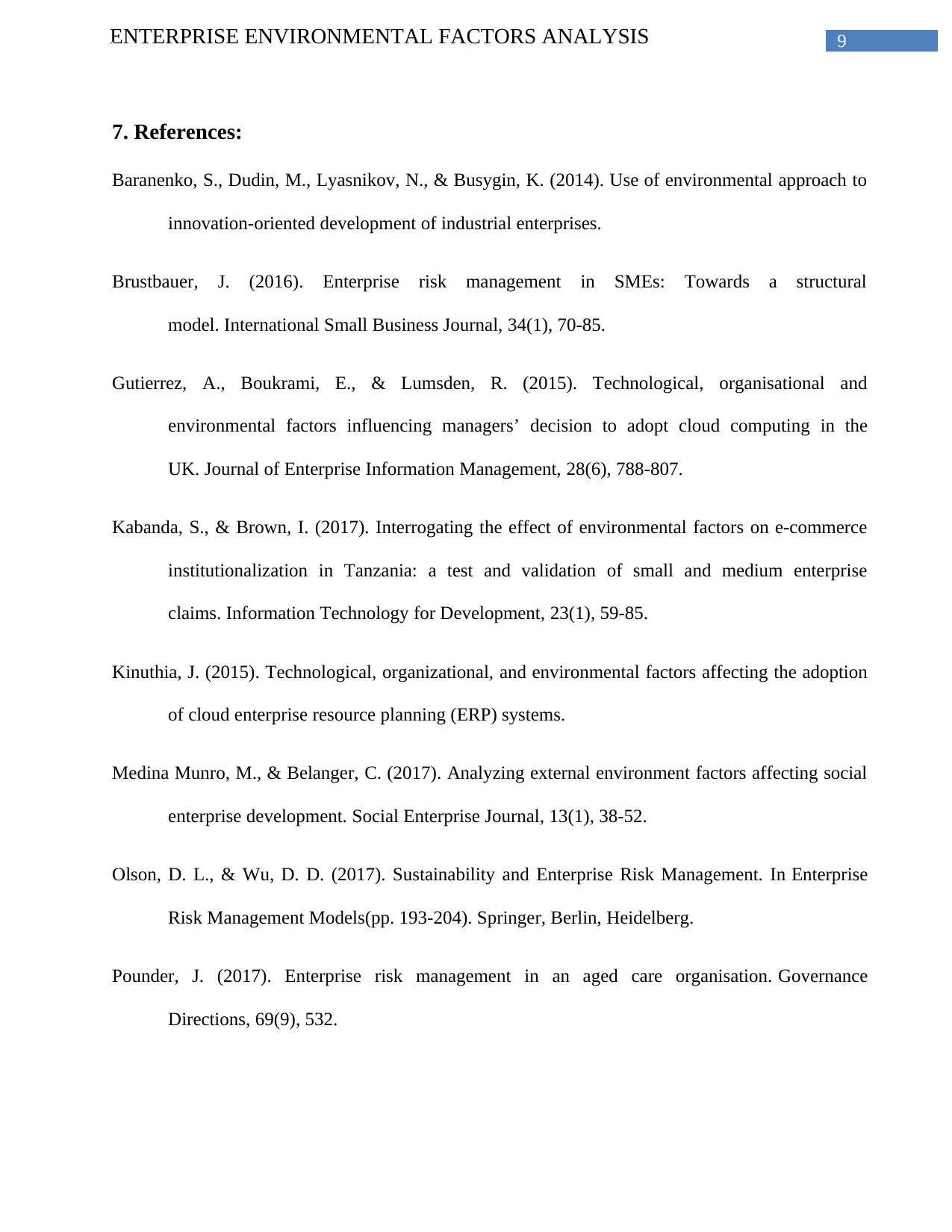
9ENTERPRISE ENVIRONMENTAL FACTORS ANALYSIS
7. References:
Baranenko, S., Dudin, M., Lyasnikov, N., & Busygin, K. (2014). Use of environmental approach to
innovation-oriented development of industrial enterprises.
Brustbauer, J. (2016). Enterprise risk management in SMEs: Towards a structural
model. International Small Business Journal, 34(1), 70-85.
Gutierrez, A., Boukrami, E., & Lumsden, R. (2015). Technological, organisational and
environmental factors influencing managers’ decision to adopt cloud computing in the
UK. Journal of Enterprise Information Management, 28(6), 788-807.
Kabanda, S., & Brown, I. (2017). Interrogating the effect of environmental factors on e-commerce
institutionalization in Tanzania: a test and validation of small and medium enterprise
claims. Information Technology for Development, 23(1), 59-85.
Kinuthia, J. (2015). Technological, organizational, and environmental factors affecting the adoption
of cloud enterprise resource planning (ERP) systems.
Medina Munro, M., & Belanger, C. (2017). Analyzing external environment factors affecting social
enterprise development. Social Enterprise Journal, 13(1), 38-52.
Olson, D. L., & Wu, D. D. (2017). Sustainability and Enterprise Risk Management. In Enterprise
Risk Management Models(pp. 193-204). Springer, Berlin, Heidelberg.
Pounder, J. (2017). Enterprise risk management in an aged care organisation. Governance
Directions, 69(9), 532.
7. References:
Baranenko, S., Dudin, M., Lyasnikov, N., & Busygin, K. (2014). Use of environmental approach to
innovation-oriented development of industrial enterprises.
Brustbauer, J. (2016). Enterprise risk management in SMEs: Towards a structural
model. International Small Business Journal, 34(1), 70-85.
Gutierrez, A., Boukrami, E., & Lumsden, R. (2015). Technological, organisational and
environmental factors influencing managers’ decision to adopt cloud computing in the
UK. Journal of Enterprise Information Management, 28(6), 788-807.
Kabanda, S., & Brown, I. (2017). Interrogating the effect of environmental factors on e-commerce
institutionalization in Tanzania: a test and validation of small and medium enterprise
claims. Information Technology for Development, 23(1), 59-85.
Kinuthia, J. (2015). Technological, organizational, and environmental factors affecting the adoption
of cloud enterprise resource planning (ERP) systems.
Medina Munro, M., & Belanger, C. (2017). Analyzing external environment factors affecting social
enterprise development. Social Enterprise Journal, 13(1), 38-52.
Olson, D. L., & Wu, D. D. (2017). Sustainability and Enterprise Risk Management. In Enterprise
Risk Management Models(pp. 193-204). Springer, Berlin, Heidelberg.
Pounder, J. (2017). Enterprise risk management in an aged care organisation. Governance
Directions, 69(9), 532.
Paraphrase This Document
Need a fresh take? Get an instant paraphrase of this document with our AI Paraphraser
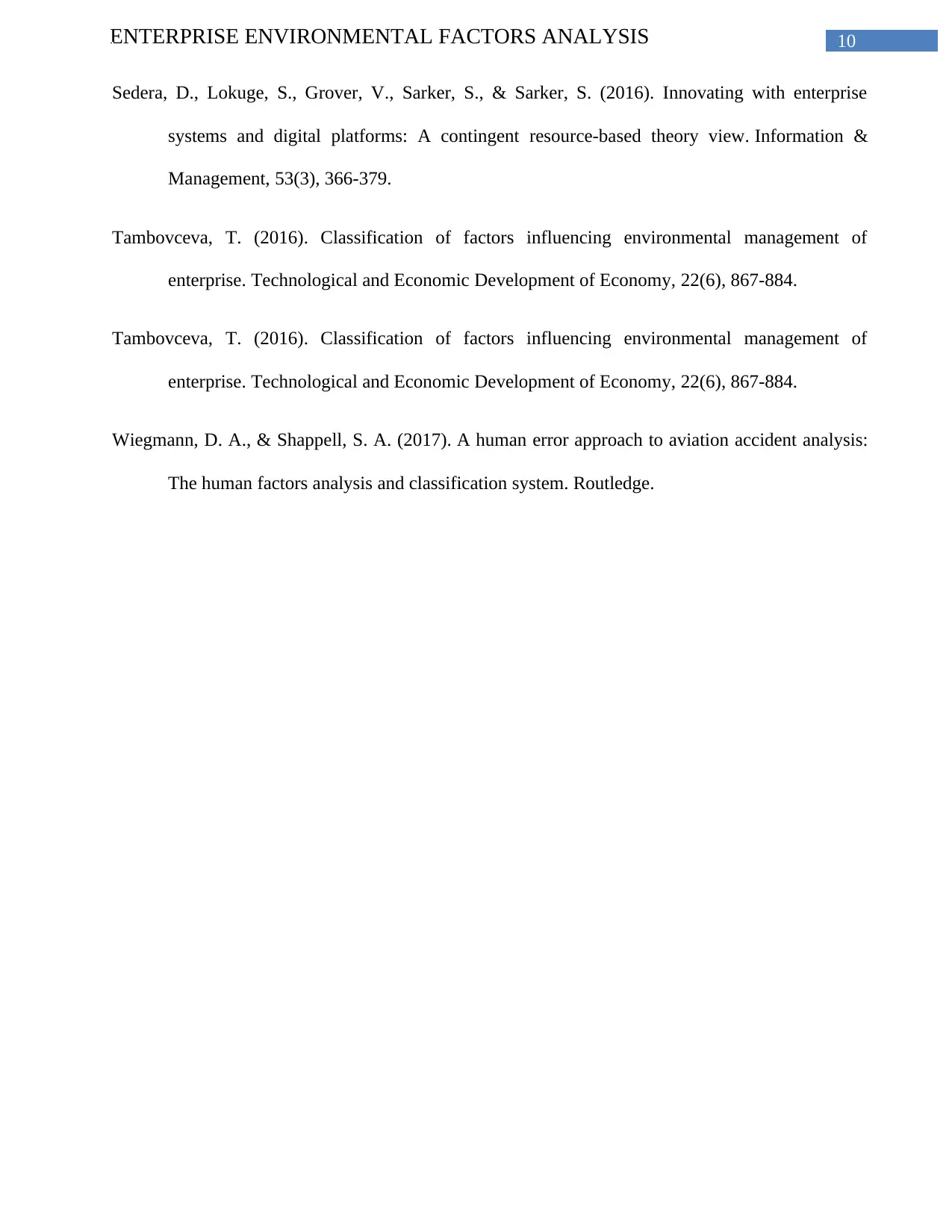
10ENTERPRISE ENVIRONMENTAL FACTORS ANALYSIS
Sedera, D., Lokuge, S., Grover, V., Sarker, S., & Sarker, S. (2016). Innovating with enterprise
systems and digital platforms: A contingent resource-based theory view. Information &
Management, 53(3), 366-379.
Tambovceva, T. (2016). Classification of factors influencing environmental management of
enterprise. Technological and Economic Development of Economy, 22(6), 867-884.
Tambovceva, T. (2016). Classification of factors influencing environmental management of
enterprise. Technological and Economic Development of Economy, 22(6), 867-884.
Wiegmann, D. A., & Shappell, S. A. (2017). A human error approach to aviation accident analysis:
The human factors analysis and classification system. Routledge.
Sedera, D., Lokuge, S., Grover, V., Sarker, S., & Sarker, S. (2016). Innovating with enterprise
systems and digital platforms: A contingent resource-based theory view. Information &
Management, 53(3), 366-379.
Tambovceva, T. (2016). Classification of factors influencing environmental management of
enterprise. Technological and Economic Development of Economy, 22(6), 867-884.
Tambovceva, T. (2016). Classification of factors influencing environmental management of
enterprise. Technological and Economic Development of Economy, 22(6), 867-884.
Wiegmann, D. A., & Shappell, S. A. (2017). A human error approach to aviation accident analysis:
The human factors analysis and classification system. Routledge.
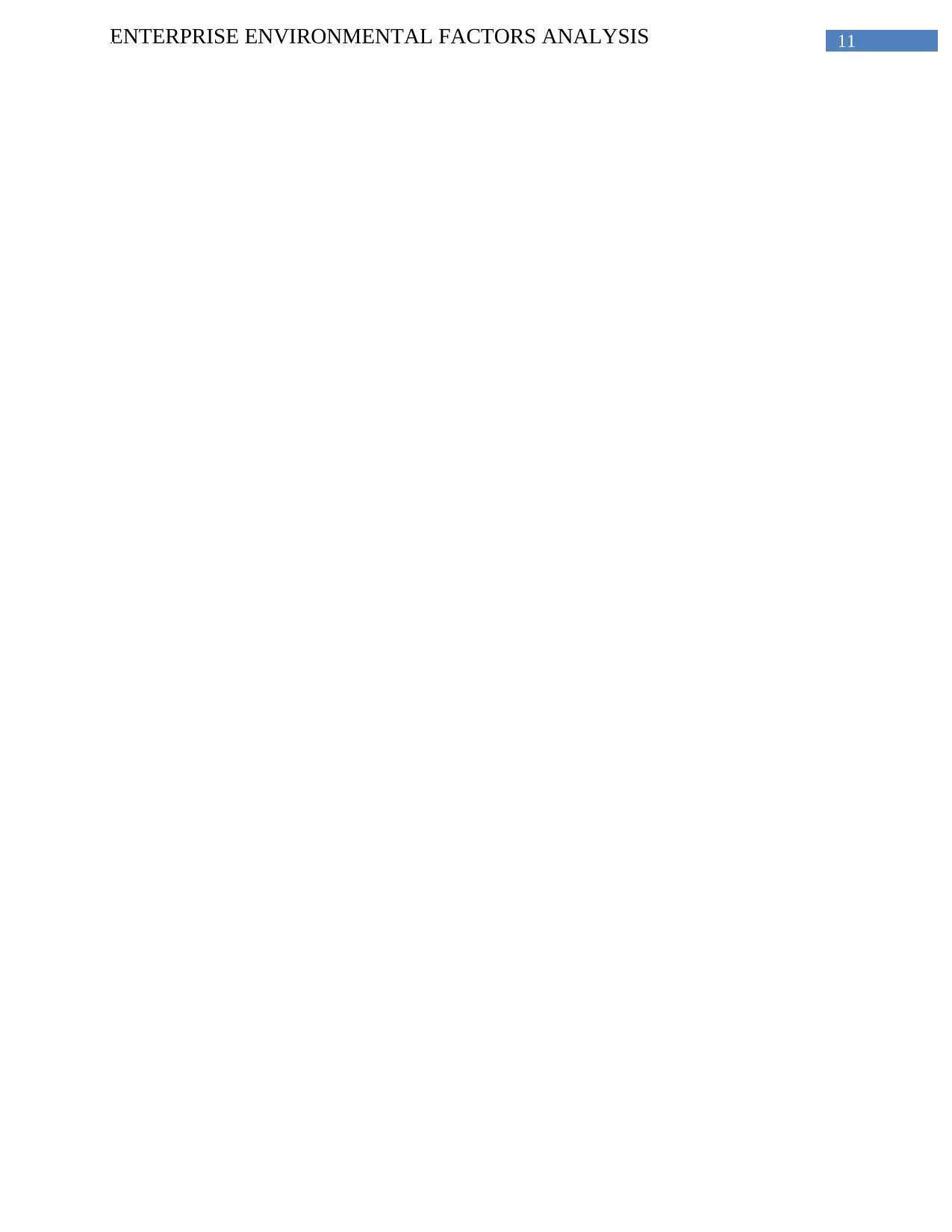
11ENTERPRISE ENVIRONMENTAL FACTORS ANALYSIS
⊘ This is a preview!⊘
Do you want full access?
Subscribe today to unlock all pages.

Trusted by 1+ million students worldwide
1 out of 12
Related Documents
Your All-in-One AI-Powered Toolkit for Academic Success.
+13062052269
info@desklib.com
Available 24*7 on WhatsApp / Email
![[object Object]](/_next/static/media/star-bottom.7253800d.svg)
Unlock your academic potential
Copyright © 2020–2025 A2Z Services. All Rights Reserved. Developed and managed by ZUCOL.




